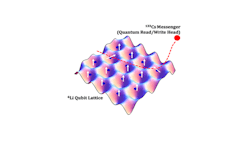A breakthrough in optic control of atoms in an ultra-cold Bose-Einstein Condensate (see “What is a Bose-Einstein Condensate?” below) is the latest advance to impact the quantum-computing space. With the careful cooling and containment of Cesium-133 and Lithium-6 isotopes in separate, overlapping, optic-lattice layers, the Chin Group at Chicago University demonstrated the ability to precisely control atomic interaction between the two layers—a breakthrough in data-transmission ability by Cs-133 atoms in a quantum computer.
The Lithium-6 atoms act as qubits, or atomic logic bits. When they come in contact with Cs-133 atoms, they transmit their logic states (dictated by their energy states) to the Cs-133 messengers. The team was able to fine-tune the frequency of the optic traps in order to achieve different Feshbach Resonances, which cause potential changes between atoms. These potentials dictate the attraction and repulsion between the ultra-cold atoms in the two layers in order to generate exact ‘open’ or ‘close’ gate operations.
Optic control of ultra-cold systems is claimed to be more precise than tuning of a magnetic field. The Chicago team of post docs and PhD students, led by Cheng Chin, were successfully able to use optic trapping to control a very complex system for high-precision operations and data transmission.
What is a Bose-Einstein Condensate?
A Bose-Einstein condensate (BEC) is a state of matter that exhibits quantum phenomena on a macroscale when neutral atoms are cooled to temperatures that are extremely close to absolute zero. Chin’s team, for example, was able to cool their BEC to temperatures on the nano-Kelvin scale.
Since the first experimental discovery of BEC superfluids by Nobel Prize winner Pyotr Kapitsa in 1938, obtaining ultra-cold and pure BECs has been the topic of research for many physicists. When Kapitsa cooled Helium-4 gas to temperatures below its lambda point (2.17 K at vapor pressure), a portion of its atoms began to reach their lowest energy state, exhibiting characteristics that cannot be explained with classical mechanics. Each effected atom slows down, exhibiting zero kinetic energy, zero momentum, and zero interactive forces. At this ultra-cold ground state, the superfluid atoms also have zero entropy.
But still, only a portion of atoms in the gas reached the lowest energy state. It took scientists decades to discover the right techniques to separate the ultra-cold atoms from the normal ones.
In this video curated by Engineering TV: Eric Cornell, 2001 Nobel Prize winner, gives an excellent explanation of the quantum behaviors of BECs.
âSuperfluid BECs
The absence of interatomic forces between atoms in the superfluidic state causes them to demonstrate zero viscosity. They flow so freely that a superfluid can leak through materials of the slightest porosity. A superfluid will also climb up the walls of its container, since adhesive forces are greater than the non-existent cohesive forces between particles. Suddenly, statistical and quantum mechanics, the uncertainty principal, and the possibility of matter occupying the same space becomes applicable to behavior of these condensates.
So how does one control matter in a state where it has such a mind of its own? The answer does not lie in a non-porous material, but rather in boundaries generated by electromagnetic fields or optic lattices. Not only are these forces used to contain BECs such as superfluids, but physicists can tune the frequencies of the fields to generate interatomic potentials that control interactions between individual particles of the superfluid.
Watch the strange behavior of a superfluid in the following video, currated by Engineering TV:
About the Author
Leah Scully
Associate Content Producer
Leah Scully is a graduate of The College of New Jersey. She has a BS degree in Biomedical Engineering with a mechanical specialization. Leah is responsible for Machine Design’s news items that cover industry trends, research, and applied science and engineering, along with product galleries. Visit her on Facebook, or view her profile on LinkedIn.

